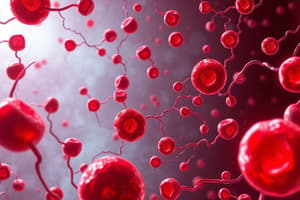Podcast
Questions and Answers
Which organs are the main sites for the destruction of red blood cells?
Which organs are the main sites for the destruction of red blood cells?
Spleen, liver, and bone marrow
What is the molecule that is formed by the degradation of haem during the destruction of red blood cells?
What is the molecule that is formed by the degradation of haem during the destruction of red blood cells?
Bilirubin
How many globin chains and haem units are present in each haemoglobin molecule?
How many globin chains and haem units are present in each haemoglobin molecule?
Four globin chains and four haem units
What is the function of white blood cells?
What is the function of white blood cells?
What are the two main types of white blood cells based on their structure?
What are the two main types of white blood cells based on their structure?
How are neutrophils characterized in terms of their nucleus?
How are neutrophils characterized in terms of their nucleus?
What is the pathological condition caused by a genetic abnormality in hemocytoblast cells?
What is the pathological condition caused by a genetic abnormality in hemocytoblast cells?
What term describes the absolute decrease in white blood cell numbers?
What term describes the absolute decrease in white blood cell numbers?
What is the term for the absolute increase in white blood cell numbers?
What is the term for the absolute increase in white blood cell numbers?
What are examples of leukopenia?
What are examples of leukopenia?
What are examples of leukocytosis?
What are examples of leukocytosis?
What group of disorders is characterized by the accumulation of malignant white cells in the bone marrow and blood?
What group of disorders is characterized by the accumulation of malignant white cells in the bone marrow and blood?
Explain the process of blood typing in determining a person's blood group.
Explain the process of blood typing in determining a person's blood group.
What are the possible blood groups of children when an individual with blood type O mates with another individual with blood type AB?
What are the possible blood groups of children when an individual with blood type O mates with another individual with blood type AB?
What are antigens in RBCs commonly known as?
What are antigens in RBCs commonly known as?
Why is it important to conduct blood compatibility testing before blood transfusions?
Why is it important to conduct blood compatibility testing before blood transfusions?
How many antigens are there that are likely to cause transfusion reactions?
How many antigens are there that are likely to cause transfusion reactions?
What are the characteristics of blood group factors A and B in terms of resistance to external influences?
What are the characteristics of blood group factors A and B in terms of resistance to external influences?
Explain the physiological basis of reverse typing in blood grouping.
Explain the physiological basis of reverse typing in blood grouping.
What must a person first be exposed to in order to produce antibodies for Rh antigens?
What must a person first be exposed to in order to produce antibodies for Rh antigens?
What is the significance of determining paternity through blood group characteristics?
What is the significance of determining paternity through blood group characteristics?
How many copies of genes coding for their ABO does each person have?
How many copies of genes coding for their ABO does each person have?
What type of genes are the A and B group genes in terms of inheritance?
What type of genes are the A and B group genes in terms of inheritance?
State the possible blood group genotype for the blood group AB.
State the possible blood group genotype for the blood group AB.
What are platelets?
What are platelets?
What is the main characteristic of anemia?
What is the main characteristic of anemia?
What are the physiological causes of anemia?
What are the physiological causes of anemia?
What are the effects of anemia on circulation?
What are the effects of anemia on circulation?
What are the specific signs of iron deficiency anemia?
What are the specific signs of iron deficiency anemia?
What causes megaloblastic anemia?
What causes megaloblastic anemia?
What are the specific signs of megaloblastic anemia?
What are the specific signs of megaloblastic anemia?
What is hemolytic anemia?
What is hemolytic anemia?
What causes hypoplastic/aplastic anemia?
What causes hypoplastic/aplastic anemia?
What are the specific signs of aplastic anemia?
What are the specific signs of aplastic anemia?
Flashcards are hidden until you start studying



